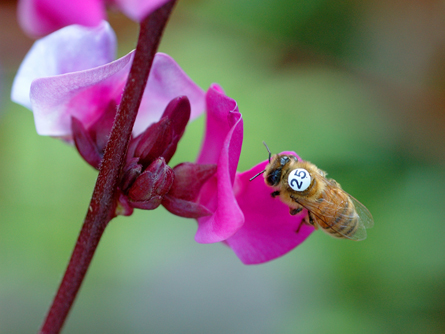Science News
Bee Adventurers
March 12, 2012

“In humans, differences in novelty-seeking are a component of personality,” says Gene Robinson, entomology professor at the University of Illinois. “Could insects also have personalities?”
In the case of honey bees, perhaps yes, according to a new study Robinson led, published last week in Science.
Robinson and his colleagues studied two behaviors that looked like novelty- (or thrill-) seeking in honey bees: scouting for nest sites and scouting for food.
When a colony of bees outgrows its living quarters, the hive divides and the swarm must find a suitable new home. At this moment of crisis, a few intrepid bees—less than five percent of the swarm—take off to hunt for a hive.
These bees, called nest scouts, are on average 3.4 times more likely than their peers to also become food scouts, the researchers found.
“There is a gold standard for personality research and that is if you show the same tendency in different contexts, then that can be called a personality trait,” Robinson explains. Not only do certain bees exhibit signs of novelty-seeking, he says, but their willingness or eagerness to “go the extra mile” can be vital to the life of the hive.
Wired UK reports that this isn’t the first study into bee personality:
A 2011 study at Newcastle University… suggested that honey bees exhibit pessimism, suggesting that insects might have feelings.
The research team didn’t stop there. They wanted to determine the molecular basis for these differences in honey bee behavior. They used whole-genome microarray analysis to look for differences in the activity of thousands of genes in the brains of scouts and non-scouts.
The researchers found thousands of distinct differences in gene activity in the brains of scouting and non-scouting bees.
“We expected to find some, but the magnitude of the differences was surprising given that both scouts and non-scouts are foragers,” Robinson says.
Scientific American describes one of the biggest surprises in the genome study:
distinct differences in 10 genes that help to control catecholamine, glutamate and gamma-aminobutyric acid (GABA) signaling—signatures that have also been linked to novelty-seeking and reward behavior in humans.
“Our results say that novelty-seeking in humans and other vertebrates has parallels in an insect,” Robinson concludes. “One can see the same sort of consistent behavioral differences and molecular underpinnings.”
Image: Zachary Huang